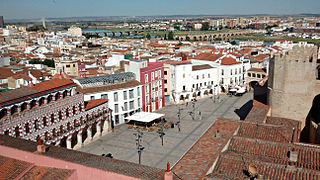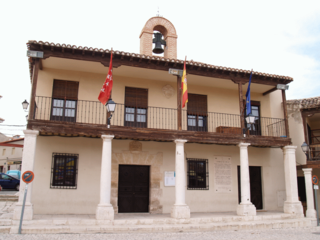
Badajoz is the capital of the Province of Badajoz in the autonomous community of Extremadura, Spain. It is situated close to the Portuguese border, on the left bank of the river Guadiana. The population in 2011 was 151,565.

The former Hospital de la Santa Creu i Sant Pau in the neighborhood of El Guinardó, Barcelona, Catalonia, Spain, is a complex built between 1901 and 1930. It is one of the most prominent works of the Catalan modernisme architect Lluís Domènech i Montaner. The complex was listed as a Conjunto Histórico in 1978. Together with Palau de la Música Catalana, it was declared a UNESCO World Heritage Site in 1997.

The Foundling Hospital was a children's home in London, England, founded in 1739 by the philanthropic sea captain Thomas Coram. It was established for the "education and maintenance of exposed and deserted young children." The word "hospital" was used in a more general sense than it is in the 21st century, simply indicating the institution's "hospitality" to those less fortunate. Nevertheless, one of the top priorities of the committee at the Foundling Hospital was children's health, as they combated smallpox, fevers, consumption, dysentery and even infections from everyday activities like teething that drove up mortality rates and risked epidemics. With their energies focused on maintaining a disinfected environment, providing simple clothing and fare, the committee paid less attention to and spent less on developing children's education. As a result, financial problems would hound the institution for years to come, despite the growing "fashionableness" of charities like the hospital.

Alzira is a city and municipality of 46,451 inhabitants in Valencia, eastern Spain. It is the capital of the comarca of Ribera Alta in the province of Valencia. The city is the heart of the second largest urban agglomeration in the province, with a population of over 100,000.

Tossa de Mar is a municipality in Catalonia, Spain, located on the coastal Costa Brava, about 100 kilometres north of Barcelona and 100 kilometres south of the French border. It is accessible through Girona Airport, some distance north.

Santa Clara is the capital city of the Cuban province of Villa Clara. It is centrally located in the province and Cuba. Santa Clara is the fifth-most populous Cuban city, with a population of nearly 245,959.

San Juan del Río is a city and administration of the surrounding San Juan del Río Municipality in the central Mexican state of Querétaro. The population in for the municipality is 268,408 as of 2015.

Calella is a municipality located in the Maresme region of Spain, located 50 km from Barcelona, 50 km from Girona, and 6 km from the Montnegre-Corredor Natural Park. It has a Mediterranean climate, and is known for its beaches, which span about 3 km.

The Franz Mayer Museum, in Mexico City opened in 1986 to house, display and maintain Latin America’s largest collection of decorative arts. The collection was amassed by stockbroker and financial professional Franz Mayer, who collected fine artworks, books, furniture, ceramics, textiles and many other types of decorative items over fifty years of his life. A large portion comes from Europe and Asia but most comes from Mexico itself with items dating from the 15th to the 20th centuries. Many pieces in the collection are fine handcrafts, such as textiles and Talavera pottery, and they are important because they are items that often did not survive because most did not consider them worth preserving.
Colegio de la Inmaculada Concepción - Cebu, also known by its acronym CIC, is a private Catholic basic education institution operated by the Sisters of Charity of Saint Vincent De Paul in Cebu City, Philippines. It began operation on May 30, 1880, in its Cebu City campus and originally was an all-girls school, making it the first school for girls in Cebu. It started to accept boys in 2010 making it co-educational.
Our Lady of Charity is a celebrated Marian title of the Blessed Virgin Mary venerated in many Catholic countries.

Colmenar de Oreja is a town and municipality of the Las Vegas comarca, in the Community of Madrid, Spain. It was subject to a seven-month siege in 1139.

Hospital Maciel is a hospital located in 25 de Mayo 174, Old City in Montevideo. It is one of the oldest hospitals in Uruguay. The land was originally donated in Spanish colonial times by philanthropist Francisco Antonio Maciel, who teamed up with Mateo Vidal to establish a hospital and charity. The first building was extended between 1781 and 1788, and later expanded on over time. The actual building is dated to 1825 with the plans of José Toribio and later Bernardo Poncini, Eduardo Canstatt and Julián Masquelez (1889). The hospital has a temple, the Charity Chapel, built in Greek style by Miguel Estévez in 1798.

St. Bartholomew's Hospital, Rochester was founded in 1078 for the care of the poor and lepers. It survived as a charity until taken over with the founding of the National Health Service. The hospital closed permanently in September 2016.

The Charity Chapel, better known as Capilla del Hospital Maciel, is a Roman Catholic chapel in Montevideo, Uruguay.

The Hospital de la Caridad is a Roman Catholic baroque charity hospital building near Plaza de toros de la Real Maestranza de Caballería de Sevilla in Spain. The Hospital is dedicated to the Blessed Virgin Mary under the venerated title of Our Lady of Charity, where a venerated 15th—century image is enshrined within the Church of Saint George of Lydda within the hospital property.

The InterContinental Marseille – Hotel Dieu is a five-star luxury hotel near the Vieux-Port area of Marseille, France. Housed in the Hôtel-Dieu de Marseille building, which served as the city's primary hospital (Hôtel-Dieu) for over eight hundred years, the hotel opened on April 25, 2013, in conjunction with the ongoing Euroméditerranée project. The hotel is part of the InterContinental hotel chain, and it is the fourth InterContinental property in France.

The Foundling Hospital Anthem, also known by its longer title "Blessed are they that considereth the poor" [sic], is a choral anthem composed by George Frideric Handel in 1749. It was written for the Foundling Hospital in London and was first performed in the chapel there. Handel wrote two versions, one for choir only and one for choir and soloists. Composed 10 years before his death, it was Handel's last piece of English church music.

The Capilla del Carmen, also known as Capilla de la Medalla Milagrosa, is a chapel located on the lower flank of El Litre Hill, in El Almendral neighborhood of Valparaíso, Chile. Built in 1928, it was run by the Daughters of Charity of Saint Vincent de Paul, who provided care to patients of the adjacent Hospital Carlos Van Buren until March 2017. The chapel was declared as a National Monument of Chile on May 20, 2003, within the category of Historic Monuments.

The Capilla de las Hijas de la Caridad de San Vicente de Paul is a Catholic church located in the city of San Fernando, O'Higgins Region, Chile. Completed in 1899, It was declared a National Monument of Chile in 1984, within the category of Historic Monuments.




















